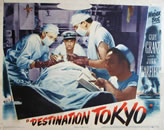The crew of the submarine USS Copperfin barely have time to enjoy shore leave in San Francisco before their boat receives top-secret orders that send it beneath the Golden Gate Bridge and back into the Pacific. Captain Cassidy (Cary Grant) leaves behind one family on shore, but he has another with him at sea—his combat-tested crew, many of whom have served with him before.
 One man who hasn’t is Tommy Adams (Robert Hutton), the Jimmy Stewart–like seaman who is still wet behind the ears—figuratively and eventually literally. Grizzled crewmember Mike Connors (Tom Tully) takes the kid under his wing. Meanwhile, self-styled ladies’ man Wolfie (John Garfield) entertains and frustrates the crew with tales of his alleged exploits with the opposite sex, while the avuncular “Cookie” Wainwright (Alan Hale, Sr.) keeps the crew fed and laughing.
One man who hasn’t is Tommy Adams (Robert Hutton), the Jimmy Stewart–like seaman who is still wet behind the ears—figuratively and eventually literally. Grizzled crewmember Mike Connors (Tom Tully) takes the kid under his wing. Meanwhile, self-styled ladies’ man Wolfie (John Garfield) entertains and frustrates the crew with tales of his alleged exploits with the opposite sex, while the avuncular “Cookie” Wainwright (Alan Hale, Sr.) keeps the crew fed and laughing.
The Copperfin’s first stop is in the Aleutian Islands, where the sub picks up Raymond (John Ridgely) and tastes the mission’s first blood when strafed by a Japanese plane. Then it’s across the Pacific for its potentially suicidal assignment—to penetrate Tokyo Bay so Raymond can sneak ashore and radio scouting reports back to the aircraft carrier Hornet, which is preparing to launch a surprise attack on the Japanese capital.
The film never mentions the name Jimmy Doolittle, but surely there wasn’t an American in the audience who didn’t know who was in command of the Hornet’s B-25 Mitchell bombers. “I hear Japs are happy to die for their emperor,” Cassidy says. “A lot of them are going to be made very happy.” Wartime audiences certainly approved the sentiment.
As the submarine captain, Grant effortlessly holds the film’s center. Whether wistfully recalling his young son’s first haircut or maintaining an unflappable cool during a grueling depth-charge attack, he is everything a submarine captain should be. (Years later he would command a sub again, in the caper comedy Operation Petticoat, demonstrating that Grant—an actor who never won an Academy Award—had tremendous range.)
The old expression says that there are no atheists in foxholes. Apparently that’s also true in submarines, because by the end of the film, Pharmacist’s Mate “Pills” (William Prince) has found the faith he denied in the beginning. Maybe it’s because submariners always gaze heavenward during the inevitable depth-charge attacks. Or maybe it’s because the power of prayer helps Pills and patient Tommy make it through an undersea emergency appendectomy. This tense surgery scene was purportedly based on a real incident. During the war, submarine crews performed at least three emergency appendectomies, including one on the USS Silversides in September 1942.
Although a little slow at first, Destination Tokyo gradually turns into a suspenseful actioner. Its wartime jibes against the Japanese may grate a little today (the captain informs his crew that the Japanese have no concept of familial love, for instance), but the time-tested concept of a submarine crew under pressure can still work. Some of the model work is a little creaky, but the underwater shots—of the Copperfin sneaking through anti-submarine nets beneath the keel of a Japanese cruiser—still look pretty good.
Copyright 310 Publishing, LLC. All rights reserved.



FOLLOW US »
